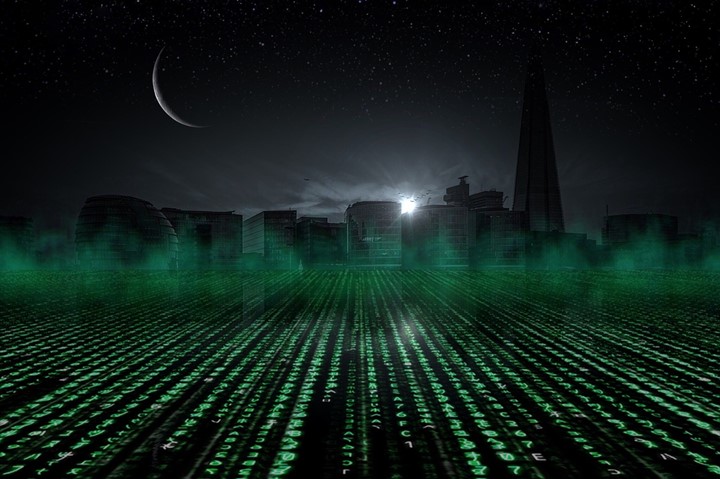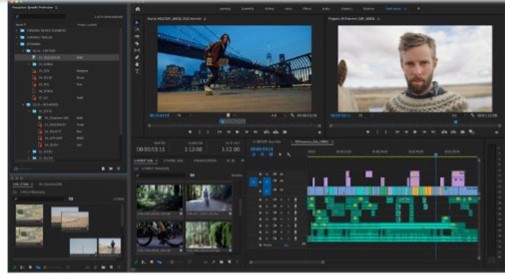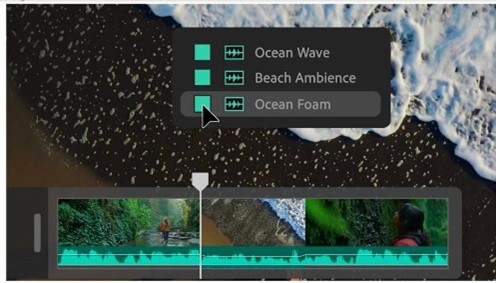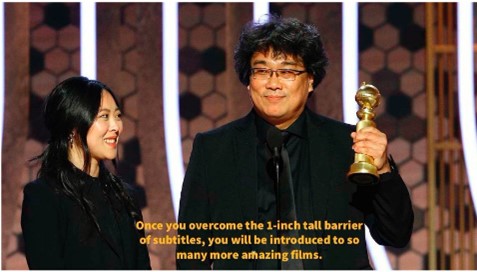The vision of AI being a helpful assistant to film and show creatives, and then slowly creeping into more and more of the person’s job until humanity is removed from creative creation, development, and production is awesomely eerie and lurking in the back of lots of people’s minds. Whether or not that is real is not yet known. There’s a big difference between a movie/show that is technically correct and one that resonates real feeling, excitement, empathy. The best course of action may be to use it lightly and wisely.

“Turns out, in my Matrix, the worse we treat you, the more we manipulate you, the more energy you produce. It’s nuts. I’ve been setting productivity records every year since I took over. And, the best part, zero resistance.” –The Analyst, “The Matrix Resurrections,” Warner Bros., 2021
For a technology that has been around since the ’40s, it’s really hard to understand all of the noise—cheering and hand-wringing—that has grown around AI over the past couple of years, especially in the content creation, production, and distribution industry. Every morning, you wake up and someone has developed the perfect AI tool that’s going to change the way we live and work. Then you hear “experts” explain how it’s going to be the second coming or the devil incarnate.
It’s not a new prophecy—the automatic loom created a panic in the 19th century, but it ended up creating more and better jobs. The typewriter was going to wipe out jobs for secretaries, but it expanded and enhanced work opportunities for millions. Yes, it did totally screw up our ability to write cursive, but that’s another story. Back in 1952, Arthur Samuel built a rudimentary AI checkers program that went on to beat the best players around. Then an AI package was developed that could beat leading chess masters. But the technology met its match when a human beat AI at the ancient abstract Chinese board game Go, a game that is almost impossible to master.
Governments the world over have rushed to develop laws and guidelines to protect us from AI world and mankind domination. That’s tough because we don’t know what we don’t know.
In the film industry, AI will probably replace some people (executives?) but will help others advance to more responsible jobs. Ironically, it will probably least affect those in the trades—key grips, electricians, craft services, for example.
Many in the industry are already using AI tools, others will have to adapt or….

WGA, SAG/AFTRA spent weeks/months hammering out guardrails with AMPTP to limit AI uses to protect writers, actors, and others in the film/show industry. Depending on which side of the table you’re sitting on, it’s either the saving grace for the visual entertainment industry or the worst damn thing that has ever been introduced for the industry.
It’s neither, and it’s both!
Good people are already using it to do some spectacular work. Bad people are using it to screw up things. Both sides will get better at what they do.
AI tools progressively made the Planet of the Apes franchise films better and better. When Kingdom of the Planet of the Apes was released, it all felt natural, even more real. You could see every hair on Caesar (and the others). Godzilla Minus One earned an Oscar for its VFX work. Godzilla is one of the few lead cast members that has gotten better with age. And Toho Studios did the whole thing on a total budget of $15 million, thanks to the very creative work of 65 artists, their AI-enabled VFX tools, in addition to their attention to detail and the budget (time/money). Go ahead, compare it to Dune: Part 2, which cost around $200 million or more and other recent two-hour-plus blockbusters that producers/directors reshoot again and again—and then have talented folks fix it in post.
There are dozens of AI-enabled tools already being used throughout a project’s development, production, post, and delivery. But maybe the most important application is at the front end of the front end of a project… before writers, cinematographers, actors, and crew get involved. So, perhaps before a studio or backer commits to the video story’s time, people, and financial budget, AI should be used to test whether the idea is worth a damn. It can be used to antiseptically determine if the premise/storyline will appeal to an audience and how big that target audience could be compared to the cost.
Prequels, sequels, spin-offs, and franchise extensions can seem safe bets, but folks can get tired, fast, with the same old same old. Every series, every film, every genre has its day and then…. Even award-winning films/shows don’t appeal to everyone because we tend to like certain genres. As film data researcher Stephen Follows points out, there may be genre spillover, but folks have a built-in bias toward certain genres, and that changes over time—and that includes individuals and those in different countries/regions.
In other words, AI can be a valuable tool by using it to wade through all the data of the projects—past and present—to give producers, directors, and studio heads a good idea if the project is going to resonate with most of their target audience beyond a gut feeling. It can help determine the film’s strengths/weaknesses, where it needs to be reinforced, and help in zeroing in on locations, cinematographers, and actors who can best deliver audience entertainment.

Yes, we understand all that stuff is dull, but it can make it easier for someone to green-light the project beyond just saying, “Yeah, we’re going to do a different, better film than Fall Guy, Quiet Place, Twister, Alien, Smile, Lion King, or another doll knockoff.” It also makes it more difficult for some studio heads to shelf the project (especially if it’s in final post), just because the person needs another tax write-off. Not impossible, but more difficult.
Consider virtual production: VP studios have cropped up around the globe because they make film production faster, better, easier, and more “real.” The quality is increasing, and the costs are coming down.
“The industry took a giant leap forward when VP LED screens were meshed with [Epic’s] gaming engine and Nvidia’s GPU (graphics processing unit),” said Allan McLennan, president of 2G Digital Post. “They deliver tools and capabilities we almost take for granted today. Virtual camera systems, real-time rendering, photorealistic CG backgrounds and AI-assisted production software is now fairly integrated in the production workflow and commonplace, whether you’re creating a 30-second spot or a two-hour film. I’m sure some greenscreen work is being done, but every production facility in operation or in construction has varying VP sets and automated systems because they can dramatically improve the development of the project while helping to reduce the time and cost.”
He continues: “As with the AI-enabled tools, they help crews be more effective and efficient. More people are able to break set and go home for dinner in the evening rather than being tied down, sometimes working seven days a week. It helps them achieve a better balance in their personal/professional lives.”

The first wave of AI tools is already being used extensively in video editing and postproduction, where folks have been able to pass off the time-consuming, tedious, mind-numbing, and, yes, boring but vital tasks. These teams have been hit with a double whammy—the need for dramatically reduced production times and reduced budgets— while executives still expect them to deliver flawless, eye-popping creativity.
Adobe, Avid, Autodesk, and other leading creative tool producers have delivered some great tools that post professionals are using in their workflow for color grading and editing, as well as analyzing/enhancing visuals, sounds, and compositions.

Adobe’s Firefly AI image and text generator works inside the company’s products to help filmmakers, editors, and post professionals unleash a new wave of creativity. Tools like Adobe’s After Effects have opened a new wave of production/post possibilities, putting resources and tools that were once only available for budget-busting projects in the hands of folks working on nearly every size of film/show. It turns “Here’s what I’d like” into “BAM!” It does this without editors, CGI experts, and other post professionals having to spend hours making and tweaking pixel and sound adjustments.
Perhaps one of the best applications of AI is in a very important and often overlooked portions of a project… the creation of film/show trailers. It really is a unique art in itself that can produce a clarion call to people to absolutely have to see a project on the screen, theater/home, or lead to “modest” results.
Previously, trailer magicians used to spend days, weeks, and months getting the best of actors, action, sentiment, and impact packed into the 3- to 5-minute mini-shows to influence the potential audience. With AI tools guided by their professional’s expertise, they are able to efficiently and effectively develop a larger number of trailers to persuade people that they absolutely, positively have to see the film/show.
One of the best AI advancements we appreciate has been the rapid rollout of AI subtitling and dubbing tools. They open up the entire world of shows/movies for people to see and enjoy, no matter where they live or their native language. The most dramatic example of this, according to McLennan, was that James Cameron’s Avatar: The Way of Water. It was created in over 1,000 versions so it could be seen, followed, and appreciated in theaters around the world.
“English may be the most commonly used language around the globe by nearly 1.5 billion people, but there are more than 7,139 languages spoken/read around the globe, with 30 being the most widely used,” McLennan noted. “People in these areas want to enjoy a film/show in their language or, as with my preference, like to hear it in its native language but be able to follow/understand the storyline by reading the subtitles.”

When Bong Joon Ho surprised people everywhere by winning an Oscar for Parasite, it broke the 1-inch-tall barrier of subtitles being only “good enough” for art theater showings and opened up new opportunities for every filmmaker, regardless of whether the project was produced in Atlanta, Toronto, Los Angeles, Mumbai, Shandong, Warsaw, Manila, Lagos, or Osaka, McLennan said.“With the use of AI-enabled subtitling and language dubbing, the industry really has reduced the barrier between the film/show developer and the project consumer,” he added.
In other words, good video stories show that the more we’re different, the more we’re the same.
Of course, as with any improvement, there are also unforeseen side effects. Psychologists around the globe have been voicing their concerns that some people may become overreliant on AI and even become strongly attached to the technologies.
One that concerns us was best exemplified back in 2013 when Spike Jonze created Her. You know, where a dude develops an unhealthy relationship/reliance with Apple’s Siri. Okay, it was a hilarious deviant relationship, but many psychologists are worried about (and studying) the reliance, attachment, and need for AI to make them complete and follow the technology down the rabbit hole.
As the Analyst in The Matrix Resurrections noted, “Quietly yearning for what you don’t have, while dreading losing what you do—desire and fear.”
A number of AI cheerleaders are even saying that it won’t be long before AI will be cranking out really good films and shows. We find that thought repulsive because the project may have all the technical features, but it can’t have the empathy, sensitivity, and, yes, mind-jolting realism that only real people can imagine, develop, and deliver at this time.
Anything can simply be seen as a waste of people’s viewing time.